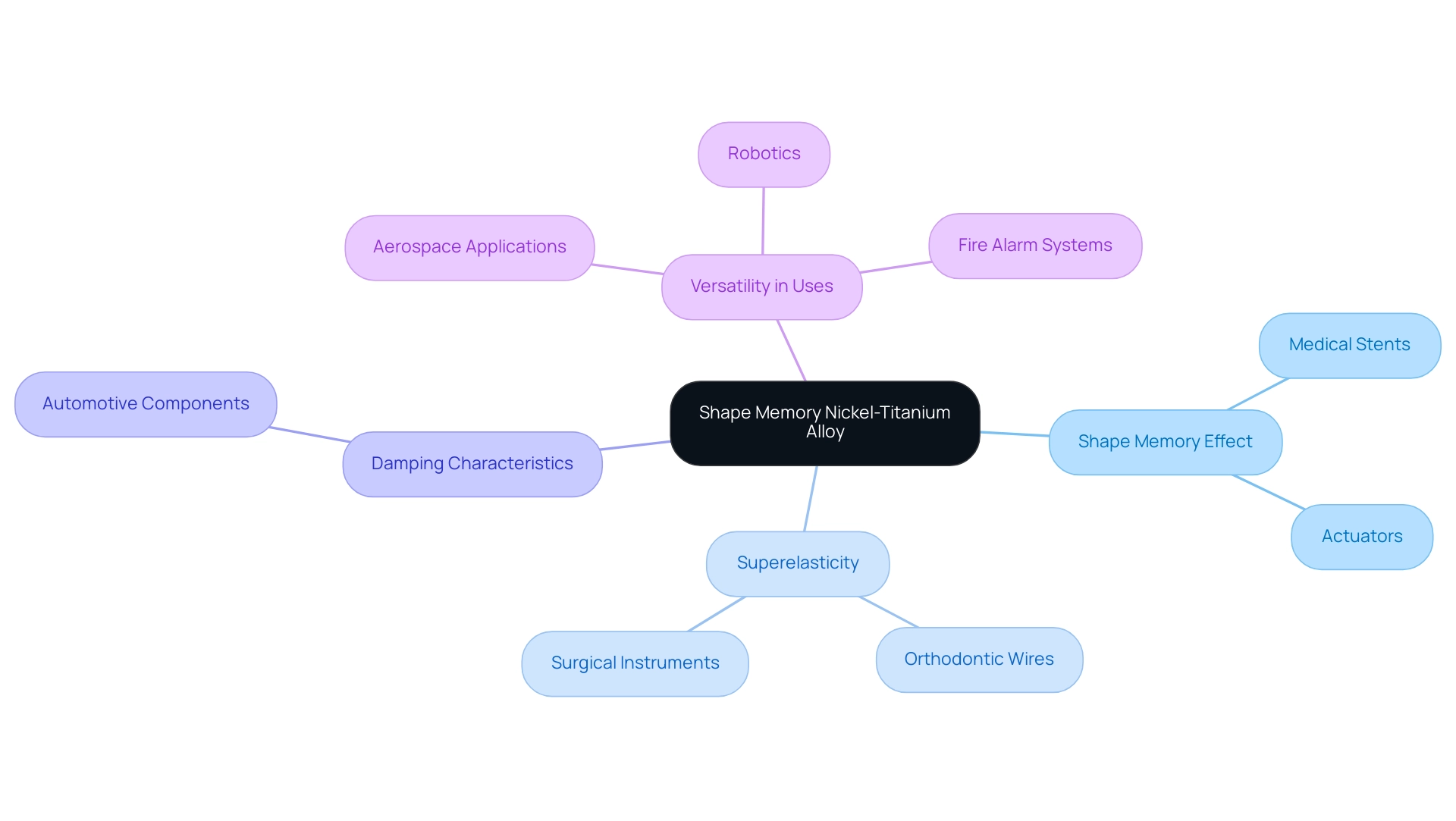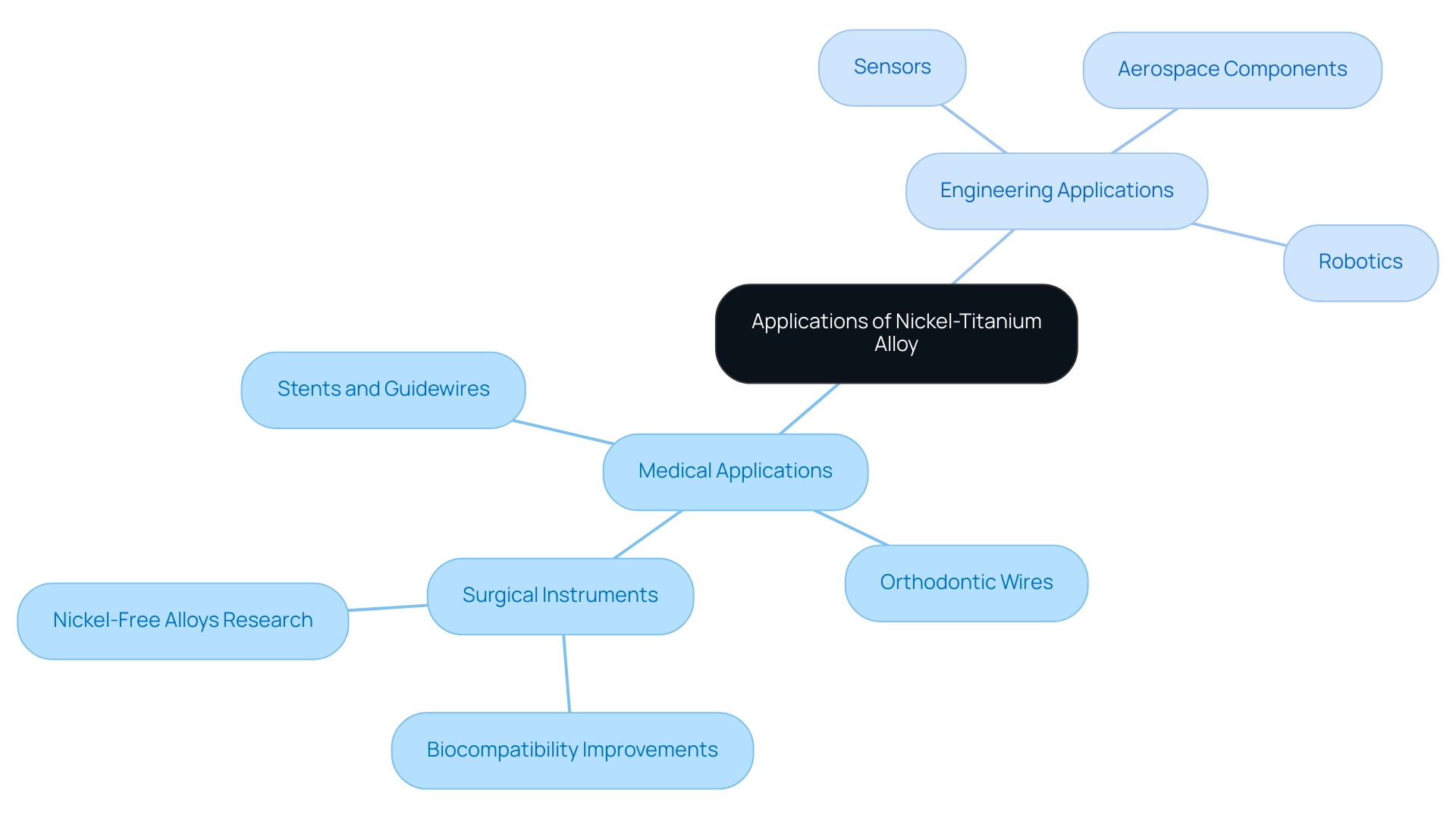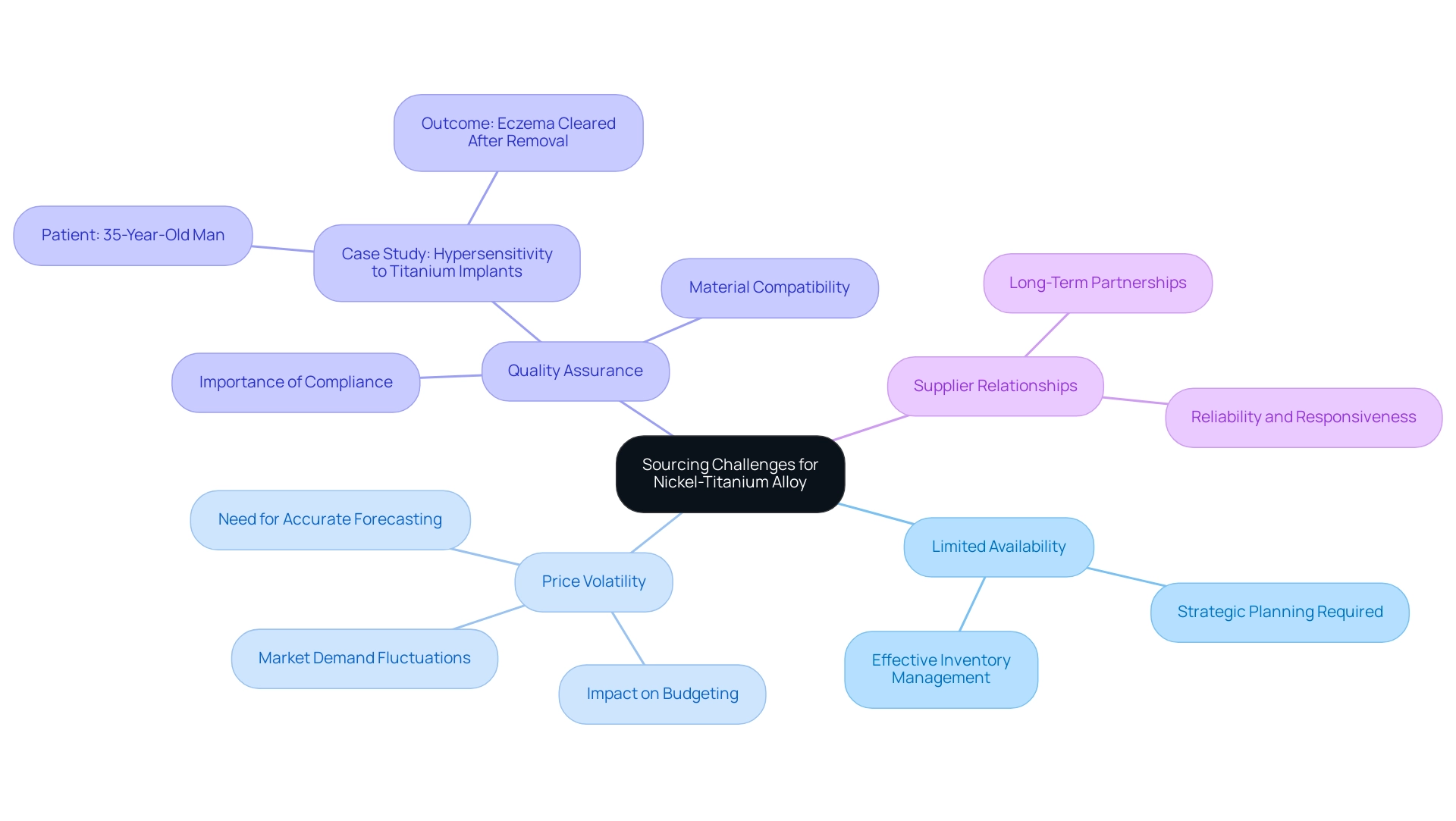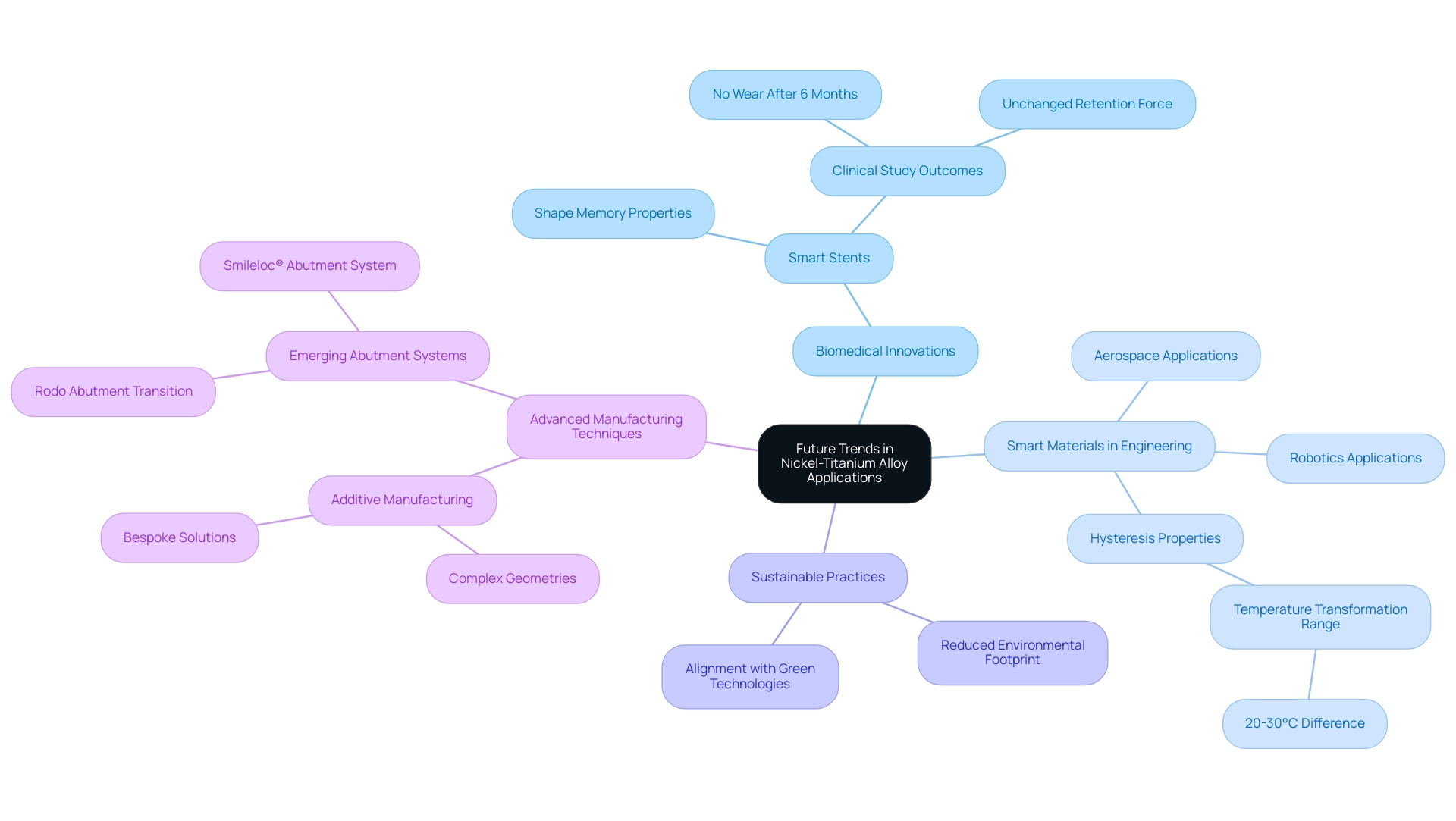Blogs

Understanding Shape Memory Nickel-Titanium Alloy: An In-Depth Tutorial on Properties and Applications
Introduction
The remarkable properties of nickel-titanium alloy (NiTi) have positioned it as a cornerstone material in engineering and medical applications, offering unique advantages such as shape memory and superelasticity. These characteristics not only enhance the functionality of devices like stents and orthodontic wires but also enable innovative solutions in aerospace and robotics.
As the market for NiTi continues to expand, projected to grow significantly in the coming years, understanding its diverse applications and the challenges associated with sourcing this alloy becomes increasingly vital.
This article delves into the fundamental properties of NiTi, its applications across various sectors, the advantages it offers, and the future trends that will shape its role in modern engineering and healthcare.
Fundamental Properties of Shape Memory Nickel-Titanium Alloy
The remarkable features of shape memory nickel-titanium alloy, including the shape memory effect and superelasticity, make it an essential material in contemporary engineering applications.
- Shape Memory Effect: This distinctive property enables the alloy to revert to its original, pre-deformed configuration when heated above a specific temperature, referred to as the transformation temperature.
Such functionality is crucial in contexts where components made from shape memory nickel-titanium alloy must reliably return to a predetermined shape, exemplified by its use in medical stents and actuators.
- Superelasticity: When the temperature surpasses the transformation threshold, this alloy can undergo significant deformation while effortlessly reverting to its original shape once the applied stress is relieved.
This quality is particularly advantageous in scenarios involving dynamic loads, such as orthodontic wires and surgical instruments, which require resilience and adaptability under varying conditions, traits that are characteristic of shape memory nickel-titanium alloy.
Damping Characteristics: Furthermore, this material exhibits exceptional energy absorption abilities, rendering it an ideal selection for uses requiring vibration dampening, such as automotive components.
Versatility in Uses: In addition to these characteristics, shape memory nickel-titanium alloy composites possess potential uses in aerospace and other sectors, further highlighting the versatility of shape memory nickel-titanium alloy in numerous high-performance scenarios. The unique characteristics of shape memory nickel-titanium alloy not only provide significant advantages across multiple sectors but also emphasize its increasing importance in modern engineering practices.
The shape memory materials market is projected to experience substantial growth, with estimates indicating an increase from USD 19.06 billion in 2024 to over USD 89.15 billion by 2037, reflecting a compound annual growth rate (CAGR) exceeding 12.6%. This growth is largely driven by increasing demand across automotive, robotics, and fire alarm systems, underscoring the material’s essential role in advancing technology. Furthermore, the shape memory metal industry in Asia Pacific is expected to expand significantly due to lower production costs and easy access to raw materials.
As Rajrani Baghel noted, ‘We have received your sample request for the research report. Our research representative will contact you shortly.’ This highlights the active engagement and interest in the ongoing developments within the industry.

Applications of Nickel-Titanium Alloy in Medicine and Engineering
Nickel-titanium (NiTi) metal exhibits exceptional adaptability, especially in the medical and engineering fields, where its distinct characteristics produce groundbreaking solutions. Jaume Pons, a recognized authority in the field, has amassed 9,537 citations, highlighting the importance of research on nickel-titanium alloys.
- Medical Applications:
- Stents and Guidewires: The shape memory effect of NiTi is pivotal in the creation of minimally invasive devices that expand within the body, playing a crucial role in vascular procedures. The market for nickel-titanium stents is projected to grow significantly, driven by their effectiveness in maintaining vessel patency and reducing complications.
- Orthodontic Wires: With its superelastic characteristics, this material is the preferred choice for orthodontic applications. The alloy delivers consistent forces necessary for effective tooth movement, enhancing treatment outcomes. Medical specialists stress its importance, stating that ‘the optimal condition to obtain good quality of sheet was investigated,’ underscoring the critical nature of these materials in achieving high-quality orthodontic results.
Surgical Instruments: The exceptional properties of this alloy not only enhance the performance of surgical tools but also improve their usability in delicate operations. The continuous advancement of nickel-titanium materials is centered on improving biocompatibility and minimizing corrosion, with studies aimed at nickel-free compositions for better performance in dental devices. A case study titled ‘Future Scope of Shape Memory Nickel-Titanium Alloys’ illustrates this advancement, showcasing research focused on Ni-free alloys for enhanced biocompatibility in dental uses.
Engineering Applications:
- Sensors: NiTi’s capacity to alter its shape in response to temperature or stress makes it ideal for various sensor technologies, including temperature sensors and actuators. This adaptability is crucial for uses requiring precise measurements and responses.
- Aerospace Components: In the aerospace industry, nickel-titanium’s high strength and lightweight properties make it invaluable for components such as actuators and coupling mechanisms, where performance and reliability are paramount.
- Robotics: The intrinsic flexibility and responsiveness of this material enable innovative solutions in robotic uses, particularly in actuation systems that necessitate precise and adaptable movements.
The varied uses of the shape memory nickel-titanium alloy not only improve medical and engineering innovations but also establish it as a crucial material for future technological progress. As ongoing research continues to unlock its potential, this material remains at the forefront of developments that will shape the future of these industries.

Advantages of Using Nickel-Titanium Alloy
Nickel-titanium alloy is recognized as a favored material across various uses because of its impressive benefits:
High Strength-to-Weight Ratio: This material is engineered to deliver exceptional strength while remaining lightweight, making it particularly advantageous in aerospace applications where minimizing weight is crucial. This quality also extends to medical devices, where every gram counts.
Corrosion Resistance: One of the most significant benefits of NiTi is its outstanding corrosion resistance. This feature is vital for components exposed to harsh environments, such as medical implants and automotive parts, effectively prolonging their operational lifespan. Barranco V and colleagues’ studies emphasize the electrochemical characterization of Ti6Al4V surfaces, reinforcing the importance of corrosion resistance in alloys used in critical applications. Furthermore, Wachi et al. emphasize that in the presence of bacterial LPS, 9 ppm Ti ions can work together to enhance characteristics related to biocompatibility, illustrating its potential in medical applications.
Versatility in Design: The distinctive properties of this material enable creative engineering solutions. The shape memory nickel-titanium alloy’s properties enable the development of designs tailored to specific requirements, enhancing efficiency and functionality in various sectors.
Energy Efficiency: The capacity of this material to regain its form and absorb energy makes it an excellent option for energy-efficient uses. This characteristic not only minimizes the need for additional materials but also optimizes overall performance, making it a valuable asset in modern engineering.
The advantages of nickel-titanium alloy are further supported by case studies, such as the critical review by Kunrath et al. (2021) on innovative surfaces for dental implants. This review illustrates the material’s biotribocorrosion performance and its relevance in medical applications, emphasizing how nickel-titanium can enhance the longevity and safety of dental implants. Moreover, with over sixty quality ISI and Scopus indexed research articles authored by Professor Ir. Dr. Nukman bin Yusoff, the credibility of NiTi’s properties is significantly bolstered. Collectively, these factors emphasize the compelling characteristics of shape memory nickel-titanium alloy materials for industries that aim to advance product performance and foster innovation.

Challenges and Considerations in Sourcing Nickel-Titanium Alloy
While nickel-titanium alloy, composed of 55% nickel and 45% titanium, offers significant advantages across various applications, procurement managers must be aware of several sourcing challenges that can affect operations:
Limited Availability: The specific grade and form of nickel-titanium alloy needed may not always be in stock, necessitating strategic planning and effective inventory management to avoid project delays.
Price Volatility: The cost of nickel-titanium is subject to fluctuations driven by market demand and raw material prices. This volatility can complicate budgeting processes and affect overall project costs, highlighting the need for accurate forecasting and flexible financial strategies.
Quality Assurance: Ensuring consistent quality and compliance with international standards is essential; even slight differences in material characteristics can result in considerable performance problems in final uses. A case study involving a 35-year-old man who developed hand eczema after receiving pure titanium implants illustrates the importance of ensuring material compatibility and quality. The removal of the titanium resolved the issue, underscoring the potential consequences of sourcing lower-quality materials.
Supplier Relationships: Establishing and nurturing long-term relationships with trustworthy suppliers is crucial for mitigating the risks of supply disruptions or quality inconsistencies. Engaging with suppliers who demonstrate reliability and responsiveness can lead to more favorable procurement outcomes.
As Ely Callaway, the retired president of Callaway Golf Company, noted, “We went from the smallest golf company in the country in 1983 to the largest in 1995… It all was done on product.” This underscores the significance of quality materials in achieving success. Furthermore, advancements in orthodontics utilizing shape memory nickel-titanium alloy wires, along with enhancements in superelastic and shape memory characteristics, demonstrate the evolving uses and significance of the material in current markets.
By recognizing these challenges, procurement managers can formulate specific strategies to navigate the sourcing environment of materials, including shape memory nickel-titanium alloy, effectively, ensuring their successful use in various industries.

Future Trends in Nickel-Titanium Alloy Applications
The future landscape of nickel-titanium (NiTi) alloy applications is poised for significant advancements, driven by emerging trends across multiple sectors:
Biomedical Innovations: The healthcare industry is witnessing a surge in demand for biocompatible materials, particularly in the development of innovative medical devices. The unique properties of the shape memory nickel-titanium alloy, such as its shape memory and superelasticity, position it as a critical material for the creation of smart stents that can adapt dynamically to a patient’s physiological conditions, enhancing treatment outcomes. Notably, a clinical study evaluated the wear and retention performance of a shape-memory metal abutment system after 6 months, finding no signs of wear and unchanged retention force, indicating promising clinical use.
The growing incorporation of smart materials into engineering uses is generating heightened interest in shape memory nickel-titanium alloy. Their ability to respond to environmental stimuli opens up possibilities for cutting-edge applications in robotics and aerospace, where adaptability and resilience are paramount. The hysteresis in the nickel-titanium alloy can be defined as the difference between the temperatures at which the material is 50% transformed to austenite upon heating and 50% transformed to martensite upon cooling, which can be up to 20–30°C, underscoring its unique properties in dynamic environments.
Sustainable Practices: As industries globally emphasize sustainability, the potential for nickel-titanium compositions to provide superior performance with a reduced environmental footprint becomes more appealing. This alignment with global trends toward greener technologies is likely to accelerate the adoption of NiTi in various uses.
Advanced Manufacturing Techniques: Innovations in manufacturing processes, particularly additive manufacturing, are set to revolutionize how nickel-titanium materials are utilized. These techniques enable the creation of complex geometries and bespoke solutions, paving the way for tailored applications that meet specific industry needs. As pointed out by Vukoman R. Jokanović, “The transition to the Rodo abutment (Smileloc® Abutment System) led to the emergence of a slightly more advanced abutment system utilizing shape memory nickel-titanium alloy,” emphasizing the advancements in abutment systems using shape-memory materials.
Incorporating these trends into procurement strategies will empower managers to strategically position their organizations for future growth and innovation in utilizing nickel-titanium alloys effectively.

Conclusion
The exploration of nickel-titanium alloy (NiTi) unveils its remarkable attributes, including shape memory and superelasticity, which are pivotal in both medical and engineering applications. These distinctive properties not only enhance device functionality—such as in stents and orthodontic wires—but also present innovative solutions in aerospace and robotics. The projected growth of the NiTi market underscores its increasing importance across various sectors, driven by the demand for high-performance materials.
Despite the numerous advantages, including high strength-to-weight ratio, corrosion resistance, and versatility in design, sourcing nickel-titanium alloy poses challenges that require careful consideration. Critical factors that procurement managers must address include:
- Limited availability
- Price volatility
- Quality assurance
- Necessity for robust supplier relationships
Looking ahead, the future of NiTi applications is promising, with trends indicating a shift towards:
- Biomedical innovations
- Smart materials
- Sustainable practices
- Advanced manufacturing techniques
By leveraging these developments, organizations can position themselves strategically for growth and innovation, harnessing the full potential of nickel-titanium alloys to meet the evolving demands of modern engineering and healthcare.




